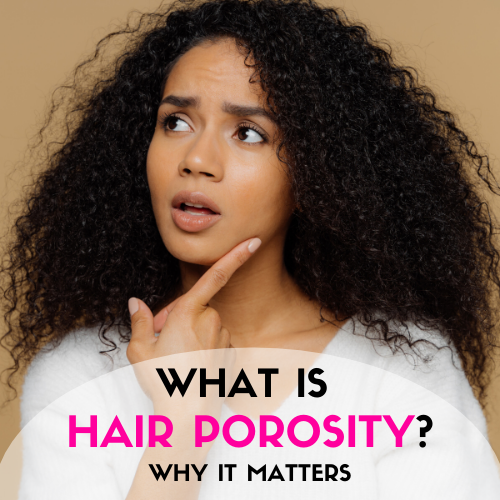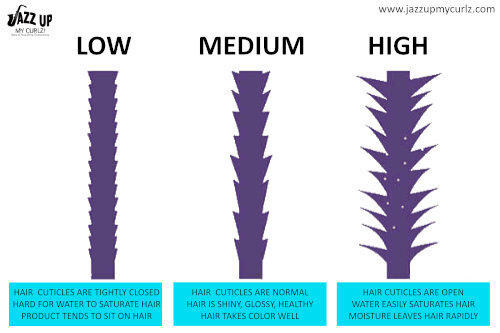What Is Hair Porosity? Why It Matters!
Let’s face it.
Hair Type is arguably the biggest topic within the natural hair community.
Hair Type is a chart that categorizes natural hair based on curl pattern. Type 1 being straight, all the way to Type 4 being tightly curly.
Hair Type charts can be controversial because they only focus on the appearance of hair. Hair type can be useful if you want a deeper understanding of hair pattern. But if you’re trying to develop an effective natural hair regimen, you can’t determine everything about your hair simply based on how it looks.
Even if you know your hair type is 3b, 4c, 2a, or any other hair pattern- it can’t always tell you what hair products will work best for your hair.
No matter how wavy, curly, or coily your hair appears, it’s not all about hair type.
This explains why 2 people having the exact same hair pattern, don’t necessarily use the same hair products.
Instead of focusing on curl pattern, there are more important hair characteristics that affect your hair growth and moisture retention.
Let me introduce you to a little known secret gem- Hair porosity.
Hair porosity is a game changer if you want an effective hair regimen that eliminates dry hair, and leaves your hair strong, healthy, and less prone to hair breakage.
What Is Hair Porosity?
Hair Porosity is a measurement of how fast your hair can absorb and retain moisture. It is THE key to finding hair products that keep your hair moisturized and improve hair manageability. Porosity is determined by the condition of your hair cuticle- the outer layer of your hair. The more open or closed your cuticles are, the more easily your hair can hold moisture.
This image shows how the hair cuticle of Low, Medium, & High Porosity affect moisture absorbency.
There are 3 categories of hair porosity:
Low Porosity-Tightly closed cuticles, hard for moisture to absorb into hair
Medium Porosity- Normal cuticles, hair absorbs and retains moisture well
High Porosity- Large, open cuticles, hair easily absorbs moisture but dries out fast
To better care for your hair, You need to know what hair porosity you have!
Here are 3 tests you can try to determine your hair porosity
The Float Test: Take a few clean strands of hair from your comb or brush and drop them in a bowl of water. Wait 2-4 minutes. If your hair floats, you have low porosity. If it sinks, you have high porosity. If it’s sitting somewhere in the middle of the bowl, you have medium porosity.
The Slip N Slide Test: Take a single strand of your hair and slide your fingers upward, towards your scalp. If you feel small bumps along the way, this indicates that your hair cuticles are raised, and you have high porosity. If your strand feels smooth, your cuticles are tightly bound, and you have low porosity.
The The Spray Bottle Test: Take a small section of your hair, and mist it with a spray bottle. Watch closely! Is the water beading up on your hair? If so, you have low porosity. If it absorbs rapidly, you have high porosity.
REMEMBER! Use CLEAN hair when trying any of these hair porosity test, hair products can affect your results!
HIGH POROSITY
Your Best Friend: Sealants!
Hair with high porosity has large gaps and holes in the hair cuticle. This allows moisture to easily enter your hair, and leave it even faster. This hair porosity is often
Frizzy, and tangled in humid weather
Super dry in cold seasons
Air dries fast
Common activities like swimming, bathing, and shampooing can increase damage and hair breakage due to the rapid absorbency rate of high porosity. You may have high porosity hair based on genetics or due to bleaching, over washing, blow drying, or straightening.
What to use to retain moisture:
Leave-in conditioners will soften your hair but moisturizers with sealants like grapeseed oil, and shea butter help prevent your hair from drying out as fast.
agave nectar, honey, Vegetable Glycerin, and Propanediol are natural humectants that smooth frizz and hydrate dry hair. hair products with humectants and sealants will allow just enough moisture into your hair and won’t increase your hair porosity.
For my high porosity hair, I lOVE the Grapeseed Buttercream of Jazz Up My Curlz! It is a moisture-rich hair cream infused with *Palm-Derived Vegetable Glycerin to attract moisture to your hair, and Cold-Pressed avocado oil, African shea butter, and Cold-Pressed grapeseed oil to seal moisture in.
MEDIUM POROSITY
Your Best Friend: Lightweight Moisturizing Conditioners!
Medium porosity hair is the most balanced hair type. Your cuticles are looser which allows moisture to penetrate your hair effortlessly, while also blocking too much from escaping. This hair porosity holds styles easily and adheres to color dyes & chemicals well. (Keep in mind that frequent use of these processes can gradually increase your hair porosity, and lead to damage!)
Here’s how to care for medium porosity hair:
Don’t use protein rich hair products in your daily regimen
Periodically use deep conditioners with protein to strengthen your hair
Lightweight hair moisturizers balanced with humectants and non-greasy emollients like grapeseed oil are perfect for your hair porosity
LOW POROSITY
Your Best Friend: Humectants!
Hair with low porosity means your cuticles are closely bound together. Although this hair type is difficult to moisturize, once moisture does penetrate your hair it stays in for a while! Your curls are often prone to build up, & protein-rich products tend to leave your hair hard and stiff.
Here’s what you should use:
Protein-free hair products with humectants like Agave nectar, Vegetable glycerin, or honey (humectants attract water & moisture to your hair!)
Hair moisturizers with emollients like shea butter, avocado oil, or olive oil.
Lighter or liquid based products like hair milks or curl refreshers will penetrate your hair easier and help avoid product build-up
Regardless of your hair porosity, there’s one effective moisturizer that all hair types need- conditioners. Natural conditioning agents, and nutrient-rich oils benefit any hair type. They moisturize your hair so it can grow healthy, and stay strong. Try out our all natural moisturizing conditioning Cream here.
Now that you know your hair porosity, you’re on your way to having a successful healthy hair journey.
So what’s your hair porosity?








